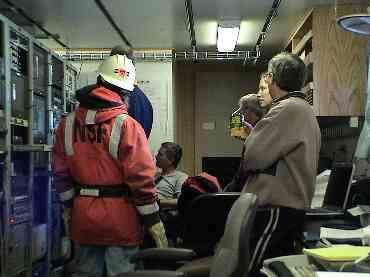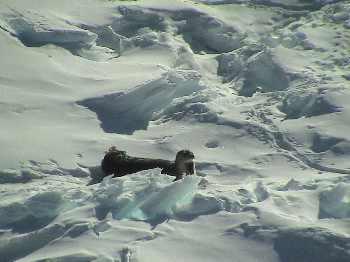3 February, 2004
A phone call woke me at 2:10 AM. Jerome Hall was calling from the
watch station and was concerned that I was OK. I had overslept,
caught in an overly realistic dream. We have been talking about how
the dreams that we have on the ship are different than we normally
have when we are home. Most of us can vividly remember the dreams
and they are so real that they are almost touchable. This new dream
experience is a bit unnerving. The details of the dreams that are
remembered well into the day seem more like memories of events at
happened yesterday.
Jill Van Tongeren was late for watch as well. She made her way up to
the bridge to begin marine mammal watch after a call from Jerome.
The next few hours went smoothly.
By 4:30 AM we were deploying the multichannel streamer, because we
would be out of the ice for the rest of the morning. We planned to
collect data along a shot line that was all ice-free open water. For
most of the morning, we had been dodging bergs and fast ice towing
the single channel streamer. The multichannel deployment takes about
forty-five minutes. While the multichannel streamer was deployed off
the winch on the back deck, we continued to collect single channel
seismic data.
At 4:45 AM the air guns were still operating, but the computers were
not storing the incoming seismic data. It took a short while for the
electronics techs to get things back on line. In that time the
single channel streamer was retrieved and the ship made a wide loop
to go back to as close to the ice edge as possible to start the new
shot line. For the rest of the morning, data collection went
smoothly with everyone on the morning shift switching between beam
editing, marine mammal observations and watch standing.
Throughout the cruise, the scientist and the ship electronics and
marine support have gotten together informally as the need arose to
discuss problems and issues in parcticular with the seismic equipment.
The single channel streamer is about 300 meters long and the
multichannel streamer is about 1400 meters long. Towing such a long
piece of equipment in the vicinity of the fast ice and bergs is a
concern for all the groups involved. To make sure that everyone is
on the same page, problems, concerns and questions are regularly
discussed in small informal meetings held near the acquisition
computers in the dry lab. It is not unusual to have six to ten
people keeping everyone up to speed on their end of the operation.
By early evening, we had complete the seismic survey and headed back
into the ice along the coast of McMurdo Sound to collect mutibeam
sonar. The goal was to filling all the missing swaths that existed
because of missing mutibeam data that had occurred due to the
necessity for the ship to dodge the ice when we were doing seismic.
When the ship is in the ice, it is a unique opportunity to scout out
for penguins and seals. The fast ice is the floating home for
colonies of Adelie Penguins and solitary seals. It is not unusual to
see small groups of penguins riding the flows from one place to
another. Occasionally they will do a near splash less dive into the
ocean, one that an Olympic diver would spend his or her career
perfecting. They swim effortlessly in the water. They nearly take
flight as they porpoise out of the water hurdling imaginary barriers
as the swim to the next flow. The approach of the ship has little
affect on the penguins. Most times they ignore us, but when we do
get to close, they will scamper to the opposite side of the flow.
Seals have a completely different agenda. Their sole priority
appears to be to get a suntan. They lay lazily on their floating ice
beach, only raising their heads to avoid getting the sun in their
eyes. They pay little attention to the ship. They don't move or
call. They simply wait until we leave so that they can lounge to the
quite sounds and soothing motion of the waves.
--

Icebergs off of the port side viewed from the 05 mid deck.

Scientists, marine techs, and electronic techs discuss data collection and deployment of the seismic streamer.

Seal sunning on an ice flow.

Contact the TEA in the field at
.
If you cannot connect through your browser, copy the
TEA's e-mail address in the "To:" line of
your favorite e-mail package.
|
